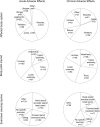Adverse effects of yoga: a national cross-sectional survey
- PMID: 31357980
- PMCID: PMC6664709
- DOI: 10.1186/s12906-019-2612-7
Adverse effects of yoga: a national cross-sectional survey
Abstract
Background: While yoga is increasingly used for health purposes, its safety has been questioned. The aim of this cross-sectional survey was to analyze yoga-associated adverse effects and their correlates.
Methods: A cross-sectional anonymous national online survey among German yoga practitioners (n = 1702; 88.9% female; 47.2 ± 10.8 years) was conducted from January to June 2016. Participants were queried regarding their yoga practice, i.e. yoga styles used, length and intensity of yoga practice, practice patterns, and whether they had experienced acute or chronic adverse effects of their yoga practice. Independent predictors of acute or chronic adverse effects were identified using multiple logistic regression analyses.
Results: Ashtanga yoga (15.7%), traditional Hatha yoga (14.2%), and Sivananda yoga (22.4%) were the most commonly used yoga styles. 364 (21.4%) yoga users reported 702 acute adverse effects, occurring after a mean of 7.6 ± 8.0 years of yoga practice. The most commonly reported yoga practices that were associated with acute adverse effects were hand-, shoulder- and head stands (29.4%). Using Viniyoga was associated with a decreased risk of acute adverse effects; practicing only by self-study without supervision was associated with higher risk. One hundred seventy-three participants (10.2%) reported 239 chronic adverse effects. The risk of chronic adverse effects was higher in participants with chronic illnesses and those practicing only by self-study without supervision. Most reported adverse effects concerned the musculoskeletal system. 76.9% of acute cases, and 51.6% of chronic cases reached full recovery. On average 0.60 injuries (95% confidence interval = 0.51-0.71) per 1000 h of practice were reported, with Power yoga users reporting the highest rate (1.50 injuries per 1000 h; 95% confidence interval = 0.98-3.15).
Conclusions: One in five adult yoga users reported at least one acute adverse effect in their yoga practice, and one in ten reported at least one chronic adverse effect, mainly musculoskeletal effects. Adverse effects were associated with hand-, shoulder- and head stands; and with yoga self-study without supervision. More than three quarters of of cases reached full recovery. Based on the overall injury rate per 1000 practice hours, yoga appears to be as safe or safer when compared to other exercise types.
Keywords: Adverse effects; Epidemiology; Injuries; Safety; Yoga.
Conflict of interest statement
Dr. Cramer is a Section Editor with BMC Complementary and Alternative Medicine. Dr. Lauche and Dr. Wardle are Associate Editors with BMC Complementary and Alternative Medicine. The authors declare that they have no further competing interests.
Figures


References
-
- Cramer H. Yoga in Germany - results of a nationally representative survey. Forsch Komplementmed. 2015;22(5):304–310. - PubMed
-
- fitogram: Yoga-Markt in Deutschland 2016. https://www.fitogram.pro/blog/yoga-markt-in-deutschland-2016/. Accessed 21 Sept 2018.
MeSH terms
LinkOut - more resources
Full Text Sources
Medical

